Illinois Neuropsychiatric Institute
Foundation and Founding of NPI Heading link
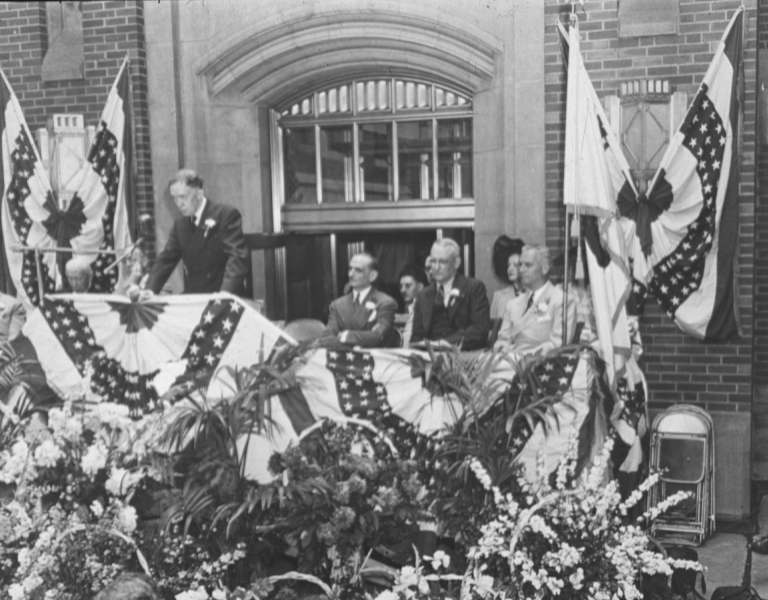
In 1917 psychiatrist Harold Douglas Singer (1875-1940) helped to found the Illinois Psychiatric Institute, but since the early 1900s he and other non-physicians such as Mr. A.L. Bowen, Director of the Illinois Department of Public Welfare (1933-41), had aspired to construct a state-of-the-art comprehensive treatment-centered hospital for neurologically and psychiatrically “afflicted” patients that would be a model for the rest of the country and the world. In 1937-38, remarkably amidst the Great Depression, they secured funding with the help of Illinois Governor Henry Horner (1933-40) to construct the NPI building. The groundbreaking ceremony for the NPI occurred in spring, 1939, and the building was constructed from 1940-41 under supervising architect C. Herrick Hammond. The NPI finally opened with a grand dedication ceremony in June, 1942. There are plaques in the entrance hallway to the north end of the NPI honoring Governor Horner, and statements from Director Bowen at the time of the NPI construction and about the Department of Public Welfare. Bowen stated:
Foundation and Founding of NPI Heading link
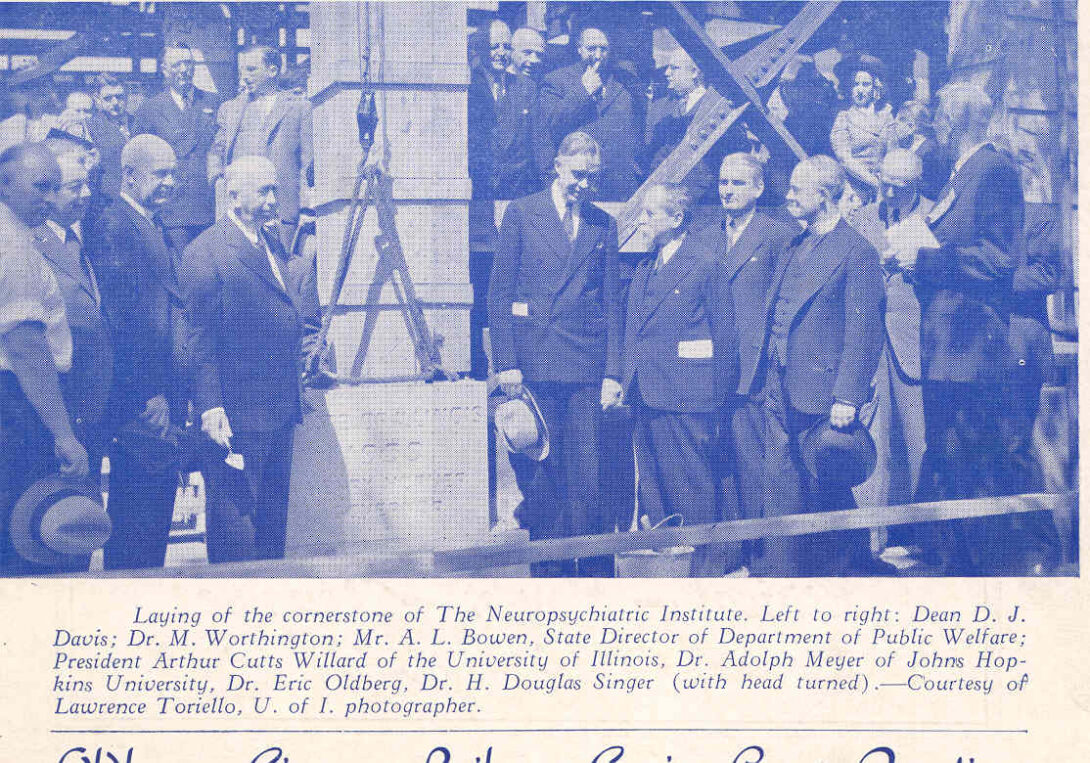
Thirty years ago I discovered in one of our State hospitals an ineffable figure, with hammer and chisel, removing, little by little, from its entranceway, an inscription, long tolerated by ignorance and superstition, ‘Ye who enter here leave all hope behind.’ Today a new inscription appears above those portals, ‘Hope all ye who enter here.’ That spirit has here enchanted out of the bare earth this beautiful work shop and study center, dedicated stone and brick upon stone and brick to the axiom of science and of human brotherhood that the happiness of life springs from good health of mind and body. Here that spirit proclaims to Illinois and all the world through the eyes and tongue of this splendid structure that the afflictions of the mind are no longer impregnable[,] no longer mysterious[,] no longer unconquerable[, and] no longer hopeless.
Foundation and Founding of NPI Heading link

The NPI building was designed uniquely based on its function as serving neurological, neurosurgical, and psychiatric patients. It was patterned after the brain with a connecting “corpus callosum” between the neurology/neurosurgery (North tower, or “left hemisphere”) and psychiatry units (South tower, “right hemisphere”).
Foundation and Founding of NPI Heading link
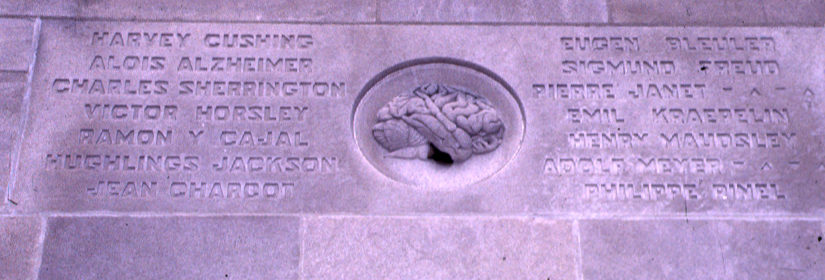
Founding fathers of modern neurology and neurosurgery (left) and psychiatry (right), Inscribed on the rear entrance of the NPI Building.
Brain slices and spinal vertebrae were sculpted on the outer walls of the building in the courtyard entranceway. It was likely the first structure to completely house these adult and pediatric services under one roof. The NPI building included in- and outpatient areas, open-air areas, a lecture auditorium, air-cooled operating rooms, a neuropathology laboratory, neuroradiology services, and dedicated neurophysiological and neuroanatomical research space.
Foundation and Founding of NPI Heading link
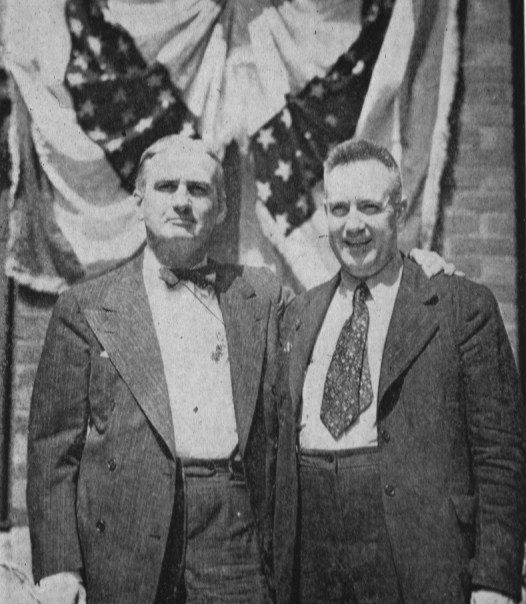
The Division of Neurology and Neurological Surgery with 54 beds and research laboratories was headed by Dr. Eric Oldberg from 1936 (prior to the actual opening of the NPI) until1971, and the Division of Psychiatry with 98 beds and research laboratories was headed by Dr. Francis J. Gerty (after Dr. Singer died in 1940). Oldberg, primarily a neurosurgeon, who had trained with the renowned founder of modern neurosurgery Harvey Cushing in Boston at the Brigham Hospital before coming to UIC in 1931, also recruited neurosurgeon and neuropathologist Percival Bailey from the University of Chicago to work in his division at the NPI.
History Heading link
-
NPI Early Years
Before the construction was completed, in November 1941 psychiatry patients were hospitalized, followed by neurophysiologists in the basement laboratories, and neurology and neurosurgery patients. Neuroradiology opened in early January 1942. The first operating room case was on December 9, 1941, a ventriculogram performed by Drs. Oldberg and Green. The second case was on December 10, 1941, a cerebellar exploration and fourth ventricle tumor resection again by Drs. Oldberg and Green. Percival Bailey, also having trained with Cushing (and co-authored a famous book on gliomas with Cushing in 1925), and with renowned German neurosurgeon Otfrid Foerster in Breslau along with neurologist Pierre Marie at La Salpêtriére in France, conducted pioneering surgical work on temporal lobectomy for non-lesional partial complex (psychomotor) epilepsy (Bailey and Gibbs), and early work on pre-frontal lobectomy for psychiatric disorders (which later fell into disuse).
Besides Bailey’s pioneering cross-over work on neurological and psychiatric disorders, he was an excellent teacher of the residents and students at the NPI. He constructed cytoarchitectonic maps of the cerebral cortex along with Professor Gerhardt von Bonin in anatomy and Dr. Ralph Gerard in physiology. Bailey’s basic and clinical neuroscience research lead to significant developments regarding the function and interconnecting anatomy of the cerebral cortex and thalamus in primates and man. A number of new cortical accessory areas were identified, as well as cortical and subcortical motor control systems (in conjunction with neurosurgeon Dr. Paul C. Bucy). With Bucy, Bailey also investigated the structure of intracranial tumors and meningeal tumors. The two confirmed that a specific type of tumor (now known as an oligodendroglioma) consisted of oligodendroglia.
Other surgical milestones at the NPI included the first pericallosal aneurysm clipping and use of loupes (Oscar Sugar), and the early successful hemispherectomy and total Siamese twin separation (Oscar Sugar). In addition to his work with Bailey, neurosurgeon Paul Bucy (at the NPI until 1954) became famous for his work with neuropsychologist Heinrich Klüver at the University of Chicago for their description of the Klüver-Bucy syndrome. Bucy resected the temporal lobes on monkeys being studied by Klüver, who was trying to discover the anatomical localization of the effect on psychosis-inducing drug mescaline. The two did not discover mescaline’s point of action but did discover consistent characteristics such as hyperorality, docility, and hypersexuality, along with lack of normal fear response and hyperphagia. The syndrome was further localized to the amygdala, and has been described not only in lobectomies, but in herpes encephalitis, carbon monoxide poisoning, and anoxic brain injury.
In neurology, clinical initiatives included the recruitment of Frederic and Erna Gibbs in electroencephalography and cerebral blood flow, and Oscar Sugar in angiography (vertebral) to visualize anomalies for the first time. Other clinical neurology emphasized multiple sclerosis (Ronald Mackay), epilepsy (John S. Garvin and Gibbs), degenerative disorders (Ben Lichtenstein), and other common conditions. Mackay, Bailey, and Bucy were later presidents of the American Neurological Association. Research staff at the NPI included director Warren McCullough (1941-1951), Gerhardt von Bonin, Walter Pitts, Ralph Gerard (1952-1955), Karl Pribram, Arthur Ward, Horace Magoun, and Erna Gibbs (wife of Frederic). McCullough developed ideas about the mathematical representation of neural networks, which laid the framework for later advances in computer models of cognition.
Frederic Gibbs was a noted neurologist before he came to the NPI, and established a comprehensive epilepsy clinic at the NPI in the 1950s, the first of its kind in Illinois. Gibbs and his wife were pioneers in EEG, and discovered many EEG correlates in neurological and psychiatric patients, building one of the largest archives of cortical EEG recordings in epileptics. John R. Hughes, MD, PhD, who was influenced by Gibbs and took his place in 1977, is still on faculty in neurology at the NPI as of 2013, conducted research on EEG in many conditions as well, and authored the authoritative EEG text, EEG in Clinical Practice. A refugee from Nazi Germany, Berlin neurologist Ernst Haase (1894-1961) was on staff at the NPI in the 1940s and 50s and conducted epilepsy research with Erna Gibbs, among other teaching and research endeavors. Haase was later secretary and vice-president of the Chicago Neurological Society (CNS) prior to his untimely death from a heart attack at a CNS meeting in 1961.
In neuropathology, Percival Bailey, Ben Lichtenstein, and later Orville T. Bailey (not related to Percival) conducted research. Bailey, using the laboratory on the 6th floor of the NPI, built a large collection of brain slices on a number of normal and neuropathological conditions such as brain tumors, cerebral hemorrhages, and brain trauma. These brain slices are on display currently at the UIC Health Sciences Library exhibit on “Mr. Neurology: Percival Bailey” (http://collections.carli.illinois.edu/cdm4/index_uic_neuro.php?CISOROOT=/uic_neuro). Residents and fellows came from the USA and abroad for neuropathology and research experience. For nearly 25 years continuously, the NPI hosted Boards in Neurological Surgery and Neurology. Many NPI trainees would later hold professorships and chairmanships in North America and abroad. One of these, John R. Green, later became head of the Barrow Neurological Institute in Phoenix. Of note, Louis D. Boshes, a neurology trainee at UIC, and Percival Bailey were acquainted in the 1940s with a famed neurologist and Nazi Europe refugee Adolf Wallenberg (describer of Wallenberg’s syndrome, lateral medullary syndrome). Wallenberg agreed to donate his neuropathological specimens to the NPI, but they had been destroyed by Allied air raids on Danzig toward the end of World War II.
-
Later Years at the NPI
 John Garvin, Marianne Wallenberg-Chermak (Wallenberg’s Daughter), and Louis Boshes at the unveiling of the Wallenberg Display in 1981
John Garvin, Marianne Wallenberg-Chermak (Wallenberg’s Daughter), and Louis Boshes at the unveiling of the Wallenberg Display in 1981Upon Eric Oldberg’s retirement in 1971, neurosurgery and neurology (established in 1936) became separate Departments under Drs. Sugar (1914-2008) and John Garvin. Since June 1, 1996, the John S. Garvin Professorship of Neurology has been endowed to the Neurology Department and held by the department head or other professor in the department, providing salary support for new faculty and enhancing the education, clinical, and research programs of the department. Louis Boshes remained on faculty as professor emeritus and established the “Natalie and Louis D. Boshes Neurosciences Library” at the NPI on the 3rd floor.
Later years
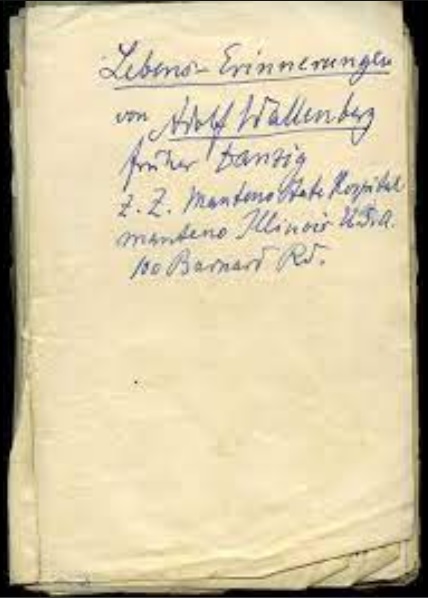 Adolf Wallenberg’s diary, NPI library
Adolf Wallenberg’s diary, NPI libraryThe library contains modern and rare neurology books, journals, and monographs, along with artifacts such as Adolf Wallenberg’s personal diary, and serves as a resource to neurology trainees and faculty. Boshes helped design the Founders of Neurology exhibit at the NPI, and was instrumental in forming the “Adolf Wallenberg: Giant in Neurology” exhibit on the NPI 7th floor containing letters, photographs, and the journal with Wallenberg’s original description in German of his syndrome.
later years
The neurology patient care units and operating rooms merged into the new University of Illinois Hospital, which opened across the street from the NPI in 1981, becoming part of the Illinois Medical District along with Rush University Medical Center, Cook County Hospital, and the Jesse Brown West Side VA Medical Center. Neurology, Neurosurgery, and Rehabilitation clinics opened at the new UIC Outpatient Care Center in 1999. Today the combined Neurology and Rehabilitation, the Neurosurgery, and the Psychiatry Departments remain vibrant, growing entities steeped in the great tradition and housed in a marvelous, fully renovated office, research, and teaching structure is still known as the NPI.
Neurology Chairmen:
- John S. Garvin 1971 – 1988
- Daniel B. Hier 1989 – 2002
- Philip B. Gorelick 2003 – 2012
- Jeffrey A. Loeb 2013 – present
Neurological Surgery Chairmen:
- Eric Oldberg 1931-1971
- Oscar Sugar 1971-1981
- Robert M. Crowell 1982-1989
- James L. Stone (Acting) 1989-1991
- James Ausman 1991-2001
- Fady T. Charbel 2002-Present
Special thanks for assembling this website information to James L. Stone, MD. Dr. Stone presented some of this information in lectures to the American Academy of Neurosurgery in Chicago (April 29, 2008) and to the UIC Neurology Department in 2007 as part of the annual Boshes lecture on the history of neurology. Dr. Stone also supplied materials on the 50th anniversary of the NPI in 1992, and on Percival Bailey which were used in part as references for the material in this website.
All photographs and material on this website are the property of the Neurology and Rehabilitation Department, the University of Illinois at Chicago Medical Center, and cannot be reproduced in any way without the permission of the department.